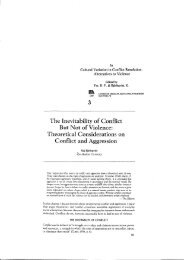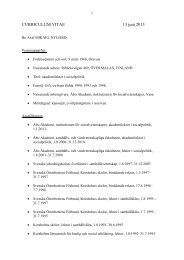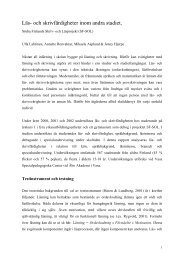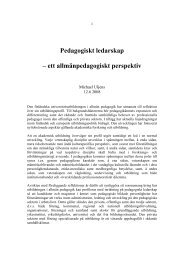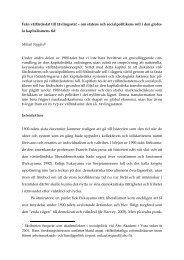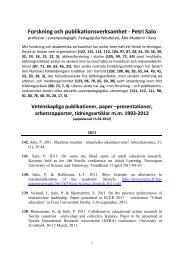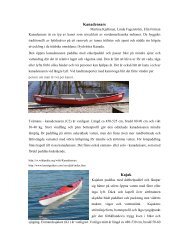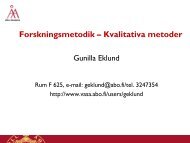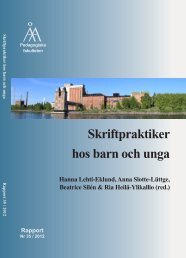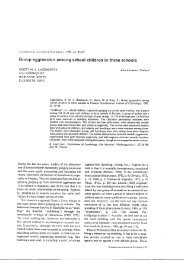Parties, Candidates and Citizens On-Line - Åbo Akademi
Parties, Candidates and Citizens On-Line - Åbo Akademi
Parties, Candidates and Citizens On-Line - Åbo Akademi
You also want an ePaper? Increase the reach of your titles
YUMPU automatically turns print PDFs into web optimized ePapers that Google loves.
underline the view stated by Margolis <strong>and</strong> Resnick (2000: 16) that the parties <strong>and</strong><br />
c<strong>and</strong>idates most likely to produce the most sophisticated websites are those with<br />
sufficient resources. These should be the major parties, since Finnish parties rely heavily<br />
on direct state funding mostly based on the share of parliamentary seats (Djupsund 1989:<br />
20; Sundberg 1996: 150).<br />
Concerning intra-party variables, both c<strong>and</strong>idate competitiveness <strong>and</strong> incumbency<br />
status proved significant predictors of both website functions <strong>and</strong> delivery. <strong>On</strong>e can argue<br />
that all significant intra-party effects lend more support a no-change scenario concerning<br />
the internet’s effect on c<strong>and</strong>idate on-line competition. As competitiveness <strong>and</strong><br />
incumbency consistently predict higher mean scores, the non-competitive <strong>and</strong> challenging<br />
c<strong>and</strong>idates seemingly do not put the same effort into their campaign web sites. Possibly<br />
due to their slim chances of election, these c<strong>and</strong>idates might not find it worthwhile to<br />
invest extensive amounts of money <strong>and</strong> effort in their general campaigns (cf. Davis 1999:<br />
94; Herrnson & Stokes 2003: 11). Their internet campaigns are lagging behind as well. It<br />
is also interesting to note that the incumbents <strong>and</strong> competitive c<strong>and</strong>idates are putting<br />
significantly more effort into their campaign sites. These c<strong>and</strong>idates possibly incorporate<br />
their sites more fully into their overall campaign strategies because they are more<br />
compelled to seize every possible vote (Kamarck 2002: 86-7). Incumbents who are more<br />
likely known to the public (Davis 1999: 94-5) might also have credibility to lose in<br />
boasting a relatively lack-lustre website. Overall, although again adding some intra-party<br />
depth to the discussion on electoral competition on the internet, these findings still<br />
mostly point in a ‘no-change’ direction. This conclusion is obviously not per se transferable<br />
to all areas of internet politics. The article has, for instance, not addressed the challenge to<br />
the no-change scenario possibly posed by new social movements <strong>and</strong> transnational<br />
movements embracing the technology (cf. Foot & Schneider 2002: Norris 2001b: 233-9;<br />
2003).<br />
In sum, what are the major patterns found in this study, <strong>and</strong> what summarizing<br />
conclusions can be drawn? Firstly, the study has shown that most c<strong>and</strong>idates did not<br />
campaign on-line, <strong>and</strong> the majority of those who did had websites which did not make<br />
full use of the possibilities of the new communication technology. The study has<br />
moreover served to shed more light on the ways in which c<strong>and</strong>idate-level electoral<br />
competition works on the internet. Evidently, even though the Finnish context contains<br />
elements which would suggest otherwise, party size is nonetheless highly influential on<br />
c<strong>and</strong>idates’ web campaigning. Both launching <strong>and</strong> further developing functions <strong>and</strong><br />
delivery aspects of campaign websites is more likely for major party c<strong>and</strong>idates. These<br />
findings lend some support to a no-change scenario vis-à-vis the internet’s impact on<br />
c<strong>and</strong>idate-level electoral competition (cf. Margolis & Resnick 2000: 54). Major parties, <strong>and</strong><br />
their c<strong>and</strong>idates, should, in theory, control more financial <strong>and</strong> organizational resources<br />
136



